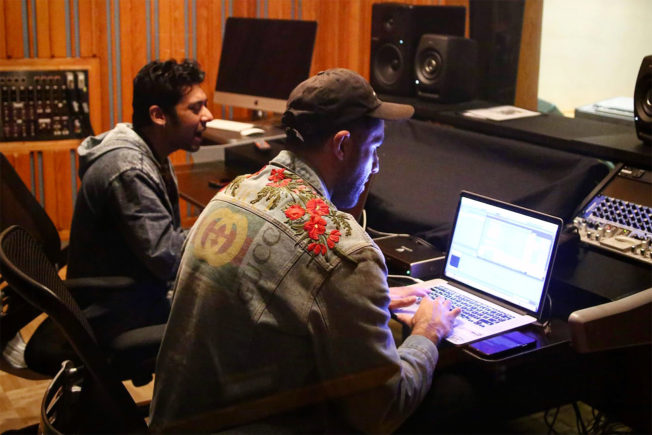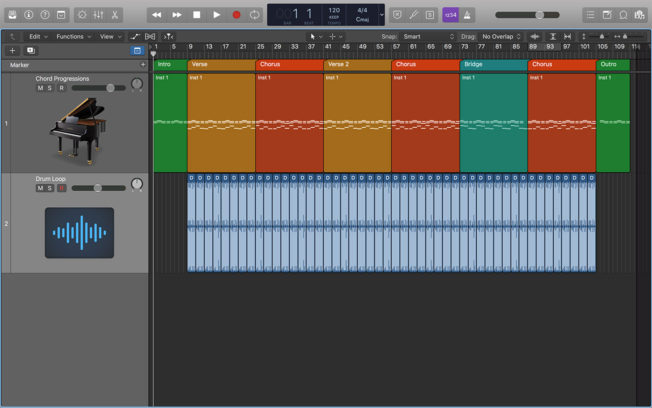Are you feeling stuck and having trouble finishing your songs? Here are some songwriting tips to help you finish songs faster when feeling stuck.

How to Finish Songs Faster?
Starting a new piece of music is one of the most fun and exciting parts of being a producer. There are endless possibilities, and you have the potential to do something you’ve never done before. But once you’ve established a basic idea, where do you go from there?
Taking a melody or an 8-bar loop and turning it into a fully produced song can be daunting and frustrating. This guide offers some techniques you can use to streamline the process and finish songs faster. Learn how to flesh out a full track from a basic melody, drum pattern, chords, or even a couple produced sections.
1. Produce ‘Horizontally’ Before You Produce ‘Vertically’
This technique can take a second to wrap your head around. When Producing ‘horizontally’ means working left to right inside your DAW. The horizontal arrangement of your song is what composes the structure and songwriting of your music. For example, looking at a finished song left to right may have a structure like Intro-Verse-PreChorus-Chorus-Verse, etc.
Looking at a finished song top to bottom or ‘vertically,’ we see the instrumentation and layers within each section. These track elements include things like Melody Layer 1, Melody Layer 2, Arp, Drums, Percussion, Sub Bass, etc.
The idea here is that before you get too deep into the actual instrumentation and layering of a track (or producing vertically), try to flesh out the arrangement and structure of the entire song first. Think of it like building a wooden frame for a house before you start filling it with furniture. Creating a skeletal version of your song first also makes producing easier. It also eliminates any guesswork. For instance, questions like “what comes after the first drop?” won’t be an issue anymore. This method also improves workflow. Producing becomes faster because your filling in the blanks rather than figuring out the next section.
Creating a Sketch Arrangement
What should this stripped back skeletal version look like? It depends on the producer. I prefer to lay out my chord structure first. It’s often the focus of my music, and usually the element I start working with first. Using a piano or simple synth sound, I’ll lay out every chord progression in my track. I might also include a simple drum beat throughout the track, so it doesn’t feel sterile. By doing this, it forces me to decide where each section starts and ends. This way there’s no guesswork in your production. You lay out a blueprint and then get to producing music.

Alternatively, if your music is more focused on drums or bass, use those elements as the foundation for your track skeleton. The goal of this approach is to build the frame that’s going to support your song before focusing on ‘vertical’ elements like mixing, layering, and sound design. Getting the basics down before the fine details will help you finish songs faster.
Producing horizontally before you produce vertically can also help with arrangement and song structure. It also gives you the opportunity to consider how those elements will function in your music. For instance, newer producers won’t give a lot of thought to the structure of a song. They often allow the song to take shape naturally as they move from one section to the next. However, that approach can result in a piece of music that feels choppy and short-sighted. Focusing on song structure earlier in your production can make a big difference both for your arrangement and the time it takes to finish songs.
2. Don’t Over Do It!
For many producers, the first thing they do is produce a full intro and drop/chorus. But after that they get stuck. Part of that has to do with hearing a finished section followed by an unfinished section. For instance, a new section can feel like it’s falling flat and not maintaining the energy from the previous section. It’s a frustrating feeling because the two sections are not going to flow naturally until they’re both finished. It’s also the culprit behind us not being able to move passed an 8 or 16-bar loop.
Furthermore, producing one full section at a time can cause us to lose track of what made our original ideas seem special. For example, a finished intro that you loved might not sound so special anymore after listening to it 500 times while working out the arrangement and other sections. Hearing a section too many times can make you desensitized to an idea that you initially thought was great.
Over-producing is something else to be aware of after producing that first great section. If you don’t execute the rest of your song efficiently enough, you can end up adding unnecessary elements to make things sound as good to you as it did initially. To emphasize, over-producing is when you add too many elements to a song. It can make your song sound too busy and like it’s lost its direction or focus. The best way to avoid over-producing is to streamline your production workflow. For example, try to get more work done in a shorter amount of time. That way your initial material will still feel fresh by the time you’ve finished producing. Also, producing horizontally before you produce vertically is a great way to ensure your workflow is as efficient as possible.
3. Use Music You Love as a Reference
A lot of producers have trouble deciding what elements work best for a particular section of music. For instance, questions like, “are these chords better for the verse or better for the chorus?” As you learn and improve, decision making will become easier. But when in doubt, look to the artists you admire. Use their music as a roadmap to guide you toward improving your music. For example, use elements of the songs you enjoy as starting points for your productions.
For instance, you can work out how other artists are using chords in their music. Start by listening to a song you like and using a keyboard to work out the root notes of the chords they’re playing. Then build your chords up from there. You can also make sketches of how their drum patterns change from section to section. Or, listen to the way the FX and drum fills are helping to transition from one section to the next.
[yuzo]
The same idea works for song structure. Throw another artist’s song in your DAW to use as a roadmap. For example, label the length and placement of each section in their arrangement. It’s also important to realize that this method isn’t “stealing.” It is learning common song structures. It’s essential to understand the structural tenets and nuances of music you like. And, incorporating those elements into your music can help you make choices on how you want your music to sound. So, it’s ok to use other artist’s music as a tool to help you.
4. Quick General Tips to Finish Songs
Here are five additional tips to help keep you motivated and productive when producing music:
1. Take breaks.
Our ears get tired, and they become fatigued from an 8-hour studio session. It’s crucial to give yourself 20 or 30-minute breaks every two hours or so. It’s also good to take longer breaks from a track. For example, take a day or even a week away from your song. When you come back to it, you’ll have fresh ears and will be able to hear details that weren’t noticeable before. Taking breaks also helps you reset and get back to being productive.
2. Set Deadlines
Workflow and motivation skyrockets when working under a deadline. We’re used to other people setting deadlines for us. But, if you set deadlines for yourself and stick to them, you’ll be surprised what you’re capable of achieving.
3. Watch Things That Inspire You
When I’m feeling worn down or don’t have any new ideas for music, I’ll watch videos of other musicians producing or performing. I regularly watch FACT Magazine’s ‘Against the Clock‘ series. Seeing other producers make something out of nothing puts me in a new headspace where I say “Hey! I can do that too!”
4. Work on Something Else
If you’re working on a song and not making progress, shift your focus. There are many other parts of producing beyond the actual act of making music. For example, try working on sound design. A lot of producers dedicate sound design sessions where they don’t work on tracks. Instead, they focus on making new sounds to implement in future projects. The new sounds might even inspire new tracks. Also, go sample hunting. One of the most common issues I see with novice producers is bad sample choice. Every producer has access to the same samples, so there’s no excuse for your samples not to be top notch. It’s just a matter of taking the time to find them. So, put that Splice account to good use!
5. Just Start
You can’t finish songs if you don’t start them. Convincing yourself to sit down and work on music can be the toughest part of making music. So many times, I have not felt like working on a song. Or I’ll sit down, open my DAW, listen one time, and immediately close it. When you’re feeling unmotivated, make a deal with yourself. For example, tell yourself that if you sit down and work on a track for 30 minutes, you can stop if you want to after those 30 minutes. In my experience, once I’ve forced myself to commit those 30 minutes, I’ve gotten over whatever feelings were making me not want to work. But if that doesn’t happen, at least you got 30 minutes of work out of yourself.
Final Words
Ultimately, making progress and finishing music has to do with making choices. The more informed and comfortable you are with your choices, the faster you can make them and get things finished. Now, go out and finish songs!